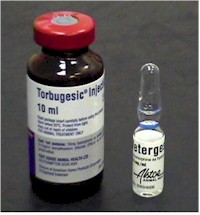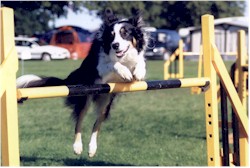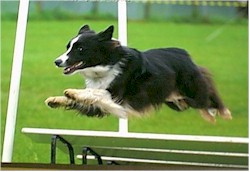Doping in Agility
|
|
|
Co-sponsors of the 2023 Winning Out
Certificates |
A lot of questions & very few answers...
|
|
NSAIDs |
 NSAIDs |
|
Opiate
analgesics such as morfine, methadone, pethidine, buprenorfine (Vetergesic*), butorphanol(Torbugesic*) and others. These painkillers are often used short-term, especially during and after surgery, or in cases where drugs from the first group don’t work anymore. |
 Opiate analgesics |
|
Cortico-steroids Some people still use these for painrelief. They don’t have any advantage over the non-steroidal painkillers and can cause more serious side effects. This group includes prednisolon (Prednicare*), methylprednisolon (Medrone*), and combination preparations such as prednoleucotropin (PLT*). |
|
Many dogs who get injured will be prescribed one of these drugs by their vet. However, many vets will not be aware that these dogs may compete in agility! Furthermore, many vets do not really understand agility and its implications for the dog. Nobody really knows how long dogs should be rested after each individual injury to make competitive agility safe and sensible again after injury. This has to be assessed separately in each case, ideally by the owner and their vet together.
Most dogs on painkillers are those dogs with chronic problems such as arthritis, often due to things like hip dysplasia, elbow dysplasia, previous joint damage or injury, lumbo-sacral disease, developmental orthopaedic problems etc. These dogs, it could be argued, should not be competing in agility in the first place. Of course there is the argument that dogs, even those with mild orthopaedic conditions, should always be kept fit and slim as much as possible and exercise is instrumental in this, but here we are talking about dogs taking part in competitive agility, with all the stresses and strains on the body’s bones and joints which this inevitably involves. I think this is a very contentious issue and one which needs further discussion.
 5.
Other groups of treatments
5.
Other groups of treatments
Many people nowadays use food supplements
such as the chondroprotective agents (e.g. Chondroitin Sulphate/Glucosamine combinations),
evening primrose oil, green-lipped mussel extract and some others. These are not drugs as such
and do not fall in the same category at all. I feel that these treatments should be allowed to
be freely used.
The second group is homeopathic medicine. As there are no known negative effects of this type of treatment and they are not really ‘drugs’ I think these are OK as well.
 The
next group is herbal medicine. Again this seems to
be totally harmless in many cases, but beware, natural doesn’t automatically mean safe!
The
next group is herbal medicine. Again this seems to
be totally harmless in many cases, but beware, natural doesn’t automatically mean safe!
Furthermore there are those dogs who have been prescribed treatment for certain clinical conditions, where the dog would suffer, deteriorate, or even die, if treatment were to be discontinued. These conditions include hypothyroidism, diabetes mellitus, epilepsy, Addison’s Disease, Cushing’s Disease and others. In some cases the drugs used in the treatment of these diseases can influence the condition, fitness or behaviour of the dogs using them and it would have to be assessed in each individual case whether participation in competitive agility is sensible, advisable or even acceptable.
Finally, nowadays there are some drugs on the market to help with behavioural modification, for instance for separation anxiety and some types of nervousness or aggression. These include clomipramine (Clomicalm*) and selegiline hydrochloride (Selgian*). The use of these drugs may make a dog more easily controllable.
Doping in the UK today
I know for a fact that there are many dogs competing in agility in
the UK today which are on some of the drugs mentioned above. At the end of the day, it is up to
the individual dog owner and handler to decide how he/she is treating his/her dog, but
in some cases competitive agility is going
to be detrimental to the health and well-being of the dog. This, of course, should be severely
discouraged.
However, who is going to police this?
Should we have ‘doping’ control?
How are we going to do this?
Blood samples at random?
Test only the winners?
Urine tests?
Who is going to pay for this?
How should we ‘punish’ the perpetrators?
Do we really want this?
There are many questions to be answered if we want to take this any further. It would be good to discuss such issues in the agility community.
P.S. The dogs pictured in the photographs have NOT ever taken any form of ‘doping’ at all!
Case Notes
 CASE
1:
The first one is from Amanda Pigg, who does agility with
her Border Collie Mika. Mika has epilepsy and is on Epiphen*. Her vet has encouraged her to
continue to compete in agility, as long as the dog is ‘controlled’, which means that the dosage
is correct for that dog. This can be checked by doing blood samples on a regular base. Amanda
has seen no change in Mika’s behaviour or demeanour. She does not condone giving this sort of
medication to dogs for other reasons than a clinical condition such as epilepsy.
CASE
1:
The first one is from Amanda Pigg, who does agility with
her Border Collie Mika. Mika has epilepsy and is on Epiphen*. Her vet has encouraged her to
continue to compete in agility, as long as the dog is ‘controlled’, which means that the dosage
is correct for that dog. This can be checked by doing blood samples on a regular base. Amanda
has seen no change in Mika’s behaviour or demeanour. She does not condone giving this sort of
medication to dogs for other reasons than a clinical condition such as epilepsy.
My opinion: I totally agree! I see no problem in dogs having a totally normal life, including agility, as long as they are under regular ‘supervision’ by their vet. Epiphen certainly does not always have the same effect on dogs. Some dogs will get a bit more ‘dopey’, but usually only temporarily, whereas other dogs become in fact more ‘hyper’. I am very much against the use of this drug for any other reason than for the treatment of epilepsy, but do not believe anyone would be stupid enough to do this.
 CASE
2:
Jayne Fuller has a WSD, Megan, with Addison’s Disease, a
condition caused by incorrect functioning of the adrenal gland. This is a rare and in some
cases debilitating condition, which needs treatment for life. Megan is on Florinef*. She has
slowed down a bit since developing the condition and now has a ‘weird’ coat, but is otherwise
OK. Florinef certainly does not alter Megan’s performance, it just keeps her alive!
CASE
2:
Jayne Fuller has a WSD, Megan, with Addison’s Disease, a
condition caused by incorrect functioning of the adrenal gland. This is a rare and in some
cases debilitating condition, which needs treatment for life. Megan is on Florinef*. She has
slowed down a bit since developing the condition and now has a ‘weird’ coat, but is otherwise
OK. Florinef certainly does not alter Megan’s performance, it just keeps her alive!
My opinion: a difficult one, I must admit. Addison’s Disease is, or at least can be, quite serious. Some dogs may have episodes of collapse at unexpected times, even though the condition seems to be ‘controlled’. They are usually less able than other dogs to deal with stress and episodes of severe exercise. I think these dogs are generally not suited for competitive agility, however each case must be taken into consideration on an individual basis, with the owner and the vet talking about any possible eventuality. I think these dogs can certainly have a ‘normal’ life and fun, but competitive agility is questionable in my opinion.
 CASE
3:
Jo Whalley’s Sam is a seven year old Staffie cross who
suffered from recurring problems with two of her toes. She regularly had pain in these toes,
leading to lameness and inability to do agility while the painful process settled down. Each
time she came back to normal within a few weeks. When we x-rayed the toes it appeared to be due
to arthritis in one toe, but possible bone cancer in the other, which was unfortunately
confirmed after we amputated this toe and sent it of to a laboratory. The normal life
expectancy after this would be between 6 and 12 months!!! We are now more than two years on and
Sam is still alive, and doing agility at top level! She is on the nutraceutical Cosequin only
for the other toe problem. Cosequin helps cartilage repair and reduces cartilage damage in the
joint. The Cosequin has not only made her totally free
of pain, but has made her happier and more lively in general, although the latter may be due
solely to the absence of the painful toe with the tumour alone. Jo would not continue to run
Sam if she had to be on painkillers and if that would make her worse in the long run. After
all, Sam is a pet first and foremost!
CASE
3:
Jo Whalley’s Sam is a seven year old Staffie cross who
suffered from recurring problems with two of her toes. She regularly had pain in these toes,
leading to lameness and inability to do agility while the painful process settled down. Each
time she came back to normal within a few weeks. When we x-rayed the toes it appeared to be due
to arthritis in one toe, but possible bone cancer in the other, which was unfortunately
confirmed after we amputated this toe and sent it of to a laboratory. The normal life
expectancy after this would be between 6 and 12 months!!! We are now more than two years on and
Sam is still alive, and doing agility at top level! She is on the nutraceutical Cosequin only
for the other toe problem. Cosequin helps cartilage repair and reduces cartilage damage in the
joint. The Cosequin has not only made her totally free
of pain, but has made her happier and more lively in general, although the latter may be due
solely to the absence of the painful toe with the tumour alone. Jo would not continue to run
Sam if she had to be on painkillers and if that would make her worse in the long run. After
all, Sam is a pet first and foremost!
My opinion: I totally agree with the last two statements. I also feel that nutraceuticals such as Cosequin are OK to use in active agility dogs, as they never mask any painful condition but only serve to prevent them happening in the first place and help repair any damage.
CASE 4: Karen Smith had a Border Collie with hip dysplasia. She had bought the dog from a breeder. Unfortunately he had a hip score of 31 (when the average for Border Collies is 14). This is quite bad really. It also inevitably leads to moderate to severe arthritis in the hip joints. She was advised by a top orthopaedic veterinary surgeon to keep him lean and to keep on doing agility as long as he was happy to do so. He subsequently competed till he was 12 years old! He has never been on any drugs during this time.
My opinion: I would never have advised an owner to do agility with this particular dog! In my opinion the sport of agility puts a lot of stress on the joints and this, combined with the pre-existing condition of hip dysplasia, can only lead to an accelerated rate of the progression of arthritis. I feel that this is not fair on the dog, in general. Having said that, reading the above you would say, well, what’s the problem? Obviously the dog has not been badly affected by all of this, otherwise he would have had to be on drugs at some stage? I don’t necessarily agree with this. This is because I see, on a nearly daily basis, dogs which seem to be happy, with owners who swear that the dog is in no pain, but at the same time I know that they are in some degree of pain, especially on the basis of my examination. These dogs lead an acceptable life and still will do agility or any other form of exercise happily, but that doesn’t mean they don’t have pain or have arthritis. Personally I wouldn’t advise dogs with proven(!) hip dysplasia or arthritis to do competitive agility. I think there are many other forms of exercise or fun things you can do with your dog.
 CASE 5:
Breda Dallimore has a dog called Lester, also
epileptic, like Mika in Case 1, and currently on Epiphen as well as Potassium Bromide. The
latter is a medication which is used in some cases of epilepsy, especially in cases when
Epiphen alone is not enough, or to help reduce the dosage of Epiphen.
Without the drugs Lester would not have a good life. With the drugs he performs well, but
is possibly a bit slower than normal and certainly doesn’t have any advantage in competitive
agility. Breda was advised by her vet to continue agility with her dog. She does agility for
fun rather than for prizes.
CASE 5:
Breda Dallimore has a dog called Lester, also
epileptic, like Mika in Case 1, and currently on Epiphen as well as Potassium Bromide. The
latter is a medication which is used in some cases of epilepsy, especially in cases when
Epiphen alone is not enough, or to help reduce the dosage of Epiphen.
Without the drugs Lester would not have a good life. With the drugs he performs well, but
is possibly a bit slower than normal and certainly doesn’t have any advantage in competitive
agility. Breda was advised by her vet to continue agility with her dog. She does agility for
fun rather than for prizes.
My opinion: The same as above in Case 1 really.
CASE 6: Owner ‘A’ has a dog ‘B’ which is on Cosequin and Metacam. ‘B’ is on those drugs as the dog has arthritis in (at least) one of its hip joints. Cosequin is explained above, Metacam is a non-steroidal anti-inflammatory drug (NSAID), or painkiller. ‘A’s vet did advise to work the dog as normal as otherwise ‘B’s quality of life would be ‘poor’. ‘A’ did say that the dog would be retired, if it could no longer work without pain.
My opinion: In general I don't think any dog should ever do competitive agility whilst on drugs like Metacam! If the dog needs a drug to suppress pain, then it is not fit to do agility. The same goes for dogs which are stiff or lame the day after training or a show. I also don’t think that dogs, whichever the breed, can only be ‘happy’ when they are doing agility! There are many other forms of exercise or fun games you can do with your dog, to keep him fit and healthy and to avoid boredom. Competitive agility puts enormous stresses on joints, which can only exacerbate arthritic changes and will shorten the dog’s active and pain free life.
CASE 7: Dog ‘D’, belonging to owner ‘C’, suffers from a heart murmur and is on Fortekor. This is an ACE-inhibitor, a commonly used type of drug to help the heart, by minimising the workload on the heart and minimising the possible side effects of the heart condition, such as fluid build-up in the chest. ‘D’ is happy doing agility, even though the dog is not quite as fast as before and seems to suffer a bit more in the hot summer weather. ‘C’ says that ‘D’ would not enjoy life as much if agility was cut out, but he would retire the dog as soon as there were more serious symptoms.
My opinion: I don’t think a dog with a heart condition should be doing competitive agility at all! Even though ‘D’ seems happy to do agility as before, it will certainly lead to a slow but sure deterioration of the condition and can cause undue stress to the heart, possibly leading to acute heart failure. Many dogs of certain breeds suffer from heart murmurs, which don’t seem to lead to any obvious symptoms, but if we want to give the dog the best chance of a long and happy life we should not be doing agility.
Why some people continue to run the dogs on medication
‘I’d rather have a
happy dog for a shorter time than an unhappy dog for a longer time.’
I can sympathise with that one, at least to a certain extent. However, how do you tell
really if your dog is happy? I know many people think that their dog can’t live without
agility. I don’t think this is true! One of my good friends has a Border Collie, who was
absolutely mad for agility. He developed a lower back problem which put him out for a long
time. The owner decided to stop agility with him, to try and keep him healthy and happy for
longer. It was hard at first, but now the dog has a perfectly normal life, probably much
better than most ordinary pet dogs, with long walks and short play sessions as well. OK, so
he doesn’t do agility, but he’s still a very happy dog!
‘My dog doesn’t
have pain if he is on this drug and therefore I think he is OK.’
However, how do you know if agility isn’t doing any long term harm? I think it is
likely that agility is too much for most of these dogs. Is it really fair to cause more
damage than necessary and to have to deal with this when it happens in the future, rather
than minimise the damage in the first place?
‘But some athletes
do their sport with painkiller injections or when they have other health problems’.
Yes, indeed! But then again, they make the decision for themselves. They make a
conscious decision to put themselves through something, knowing what the possible
consequences are. We are capable of reasoning and make decisions accordingly. Dogs are not.
They are dependent on the decisions made by their owners and we owe it to the dog to make the
best decision for them, not for
us!!!
Finally
The above opinions on the cases, presented from the world of agility, are purely my
own personal opinions. They are based on a combination of a knowledge of veterinary science as
well as an understanding of the sport of agility. Of course you don’t have to agree to any of
them! At the end of the day, everybody is different and has a right to his or her opinion.
Every dog owner has a responsibility to his or her dog to look after it in the best possible
way. This may involve agility or not, it may involve drugs or not. We do have to consider in
each and every case whether we are doing the very best for the dog’s health, well-being and
happiness. We have to balance the pros and cons in each individual case, preferably together
with the vet. After all, he or she will be able to give you at least some advice on the likely
progression of the condition your dog may have. However, beware that not every vet will fully
understand the ins and outs of competitive agility!
 About
the author
About
the author
Peter van Dongen
Drs.(Utrecht) Cert.VR., MRCVS qualified as a vet
at the Utrecht Veterinary school, The Netherlands, in March 1990. He worked in a mixed practice
in Louth, Lincolnshire, UK, for three years, before moving to Borough Green, Kent, UK. At the
same time he limited himself to small animals only. Since December 1996 he has run a branch
practice in Allington, nr. Maidstone, Kent (UK)
In May 1995 Peter started agility (after years of just thinking about it!) with his Jack Russell Cross Basil' (a bitch!), then five years old. Since then they have qualified for many finals, including Crufts and Olympia. Basil, Peter's first and still only agility dog, is now an Advanced dog, highest level in the UK, and still going strong at the age of nearly 12 years! Basil has won the coveted Crufts 2001 title in the individual Mini Agility.
Peter passed the British Agility Club Instructors' exam in October 1999 and has since done the British Agility Club Judging Workshop.
Since 1998 Peter has written many veterinary articles for Agility Voice, Agility Eye, the Agilitynet web site, Clean Run magazine and various other publications. In 2001 he published his own veterinary care book 'Vets & Pets'.
Peter and his wife Carry still live in Borough Green with their two dogs and two cats.
|
Peter van Dongen is the author of Vets & Pets, a bound collection of a series of
articles |
If you have any comments on this article or the important and controversial issue of doping in agility, send them to Agilitynet. Please include the title in the subject line of your email and your full name.
From Karen Smith
As my dog, Whizz,
is featured in Peter's case study notes, and as, in his opinion, Whizz shouldn't have done
agility I'd just like to state the actions that I took that helped me arrive at the decision to
do agility with Whizz.
Whizz was my first Border Collie. I bought him as a pet and also with obedience and agility in mind. When Whizz was about eight months old I noticed that when he was lying down he stood up slightly strangely. Instead of leaping to his feet he sat up first, then stood. It wasn't something really noticeable and he wasn't lame when he got up, but I just thought I'd like to have it checked out.
I took him to the vet who advised an x-ray. When this was done the vet told me that he didn't have great hips. I was pretty upset and asked what I should do in terms of the obedience and agility career I had in mind for him. I was referred to the RVC and saw one of the specialists there, who is still the chief scrutinizer of the BVA hip scoring scheme. He looked at Whizz's x-rays and examined him and told me that in his opinion I should try agility with him if I wanted to, that border collies couldn't be wrapped in cotton wool anyway, and I should take the lead from my dog as to whether he wanted to jump or not. At under a year old Whizz was too young to be hip scored at the time so I couldn't have him scored straightaway.
When he was just over a year old I started agility with him. He took to it very well and took me from starters to advanced. The knowledge that he didn't have great hips meant that I didn't just run him round and round at training. When I trained him it made me more focused about what I wanted to achieve in each training session. I stopped when I had achieved what I wanted to, not necessarily when the class was over.
When he was 4 I decided to have him neutered and at the same time I decided to have him hip scored. It was for my own information as much as anything else and I also thought that it was the right thing to do to assist those people involved in the genetics of hip dysplasia - no good if only the good x-rays are sent to the BVA for scoring. His hip score came back as 15 : 16 - total 31 which although not good, was not as bad as it could have been given that the score is out of a total of 106. I was also glad that it was an even score. By this time Whizz was doing very well in the ring and had an effortless jumping action. In fact, had it not been for those initial doubts when he was eight months old and the fact that I had had him hip scored I don't suppose anyone would have been any the wiser.
Whizz competed until he was 12, and it was me who made the decision to stop, not him. It just felt, to me, like the right time. He is now approaching 16 and still isn't on any drugs. He doesn't appear to be particularly stiff given his age. He still goes out for his walks every day and despite being pretty blind and deaf now he would still like to run and retrieve a toy if only he could beat the younger ones to it! I don't regret doing agility with him for one moment and I like to hope that if he could talk he'd say the same. It gave me, and him many years of enjoyment." (25/03/02)
From Gill Zuczkowska
I thought this arti(25/02/02)cle
was extremely thought provoking and a little bit scary!
(25/02/02)
|
[bottom.htm]
© Copyright Agilitynet
|